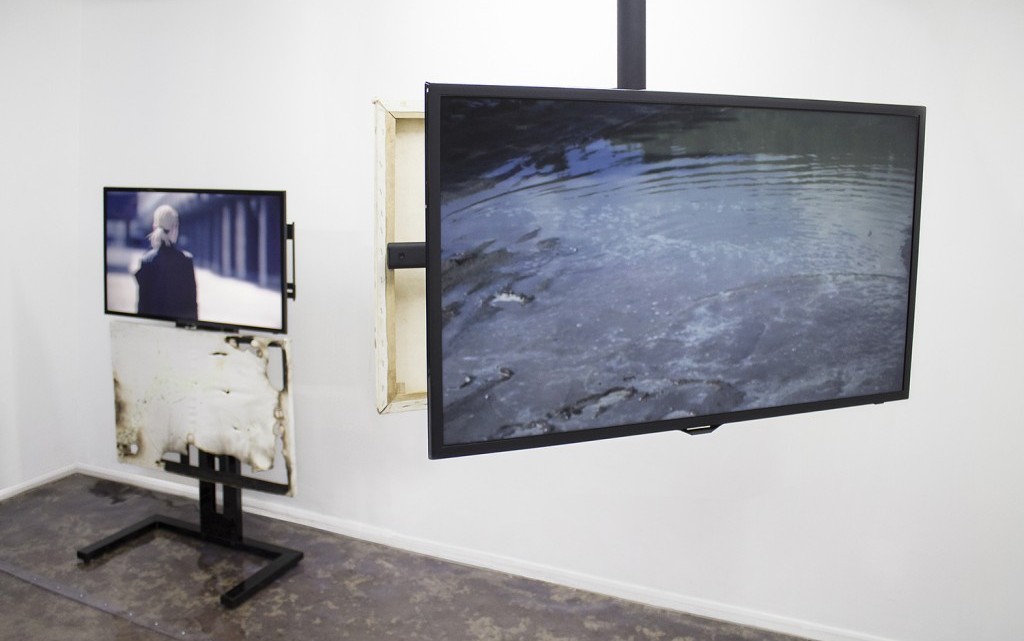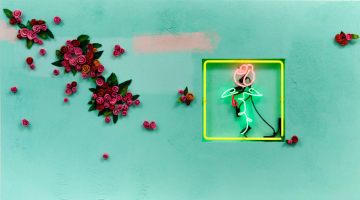Dora Budor: “Action Paintings”
247365
131 Huntington Street, Brooklyn, New York 10002
February 14–March 9, 2014
Croatian artist Dora Budor’s most recent solo exhibition “Action Paintings” took the form of a three-channel video installation that also included three monitor-sized canvases and an elaborate floor piece made of “dirt makeup.” Budor’s three videos each subtly take on the combinational emotional tone, blocking, and energy of some of the most internationally popular action movies: “The Hunger Games,” “The Matrix,” “Mission Impossible,” and “The Bourne Supremacy.” While the mood of each video relates to these films, the role of the protagonist is played by professional German stunt double Helga Wretman in all three of Budor’s videos. These basic qualities of tone, movement, and narrative tension become distinctive to each video as they have been specifically “scripted” by Budor, who gave a different treatment to the film crew and individualized scripts that focused on emotion and facial expressions; for Wretman, a kind of acting she rarely employs as a body double. By utilizing the singular painting as a substitutive object in her video narratives, through “Action Paintings” Budor has at least termporarily remedied the oft-confronted impasse of many video artists with regard to editions and the medium’s endless multiplicity, while at the same time dissecting and magnifying some of America’s most common action movie tropes.
The implications of doubling continue to permeate through “Action Paintings” as Budor, whose blonde hair, height, and body build closely matches Wretman’s, also appears in the videos at certain points during high-tension chase scenes in which distinctions between the “good guy,” or in this case woman, and bad woman, become blurred. Even in Budor’s installation an inescapable duality is reinforced, as each monitor is connected by its frame and hinges to a tarnished and beat up white canvas, which, during filming, was used by Wretman as yet another stand-in for various shields, weapons, and gear used to protect oneself and engage in physical battle.
By attaching the corresponding canvases to each video (a clear, metaphoric superimposition), the videos become dependent upon the paintings’ singular physicality, somewhat ironically rendering both the videos and the entire installation impossible to remake or duplicate. Each video, complete with a generic, suspense-driven original score that loops and loops, conjures the sensation of waking up to the DVD menu playing the same excerpt of a theme song on repeat. Through this looping effect, viewers watch the fearless Wretman, the illusive Budor in the background, and the canvases as proxy–now imbued with the precious status of paintings withinin the white cube–courageously journey through forests, shadowy abandoned parking lots, and other stereotypical settings for “high voltage ACTION.” During these battles, conquests and defeats we see each canvas endure a new scar as they are torched, slashed, ripped and bent, all of which is then present within the work in front of us. Here, the symbiotic, inherent relationship between video and canvas becomes seamless.
Budor’s transformation of the gallery floor gels these three video-paintings into one complete installation that cannot be broken up into individual works. Under sheets of clear plastic is a layer of brown, caked material that appears to be simply a sampling of dirt, but is in fact a special kind of makeup made to look like dirt or soot that is used on movie sets. Budor combined two hues of this makeup and applied it liberally to the gallery floor. Then, sealing it over with plastic, she created a new, flat surface that mimics the façade of the face of the actor.
Altogether, the three videos, three paintings, and the applied flooring combine to produce a strange effect that is both familiar and yet vastly eschewed from our normal experience of movie watching. In this way, Budor highlights aspects of such box-office shattering, blockbuster films that get utilized over and over again in order to produce sensationalized effects that over time become dulled like a pleasure center in the brain that gets overwrought with stimulants and malfunctions. The “Action Paintings” videos, in their striking similarity, begin to reveal an unspoken language within which audiences can identify the kinds of default dichotomies that most often structure such movies. This repetition creates cues for viewers’ standard emotional highs and lows through such binaries as heroes and villains, danger and complacency, victory and doom.





